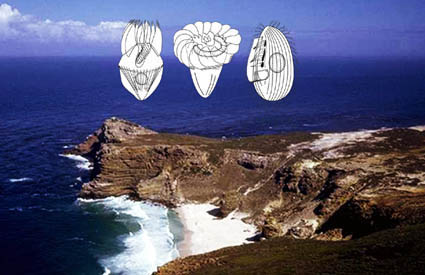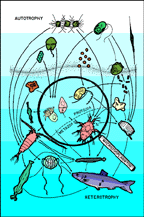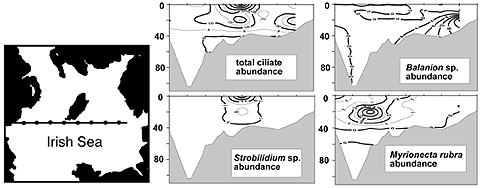Welcome to the Planktonic Ciliate Project on the Internet
The user-friendly guide to coastal planktonic ciliates
MC Strüder-Kypke, ER Kypke, S Agatha, J Warwick, DJS Montagnes
Introduction

This guide has been primarily funded by NERC for one year, starting in August 2000. We will continue to provide this service to the public and scientific community to the best of our ability after this funding is exhausted. We welcome other sources of future funding. We are developing this site and invite your comments, suggestions, and contributions. Please send an email to ciliate@liv.ac.uk.
The guide is divided into several sections:
CONTENTS The species are listed alphabetically on this page.
SCHEMATICS Schematic drawings of the major ciliate groups show their characteristic features. Species affiliated with a group are listed below the drawing.
DATA SHEETS For each species there is a data sheet, comprised of two pages. These sheets are primarily illustrative, using different fixation and staining methods. We also provide information such as: key features, measurements, ecological data, references, a detailed taxonomic description, and lists of similar species and/or synonyms.
METHODS Common sampling, fixation, and staining techniques for planktonic ciliates are briefly explained.
GLOSSARY Terms used in the descriptions are explained and illustrated where appropriate.
REFERENCES The references from all sections are combined in an independent list.
HELP The instructions will lead you through the organisation of the web page and provide more detailed information about the options.
All pages can be downloaded as PDF-files and printed out in a standardised format (on letter or A4 paper). Additionally, a compressed file (Ciliate_website.exe) containing the entire guide is available (link on the help page). This self extracting file can be downloaded and saved to your local hard drive and then browsed in offline-mode; this will significantly decrease access times.
On a regular basis we will add new data sheets of species and update existing data sheets; updates will be announced via a mailing list. Also, changes can be reviewed through the update log. To sign up send an email to ciliate@liv.ac.uk.
Ciliates in Food Webs
Planktonic ciliates are important in the transfer of material through coastal food webs; they act as a link between small phytoplankton and larger zooplankton (Reid et al. 1991). Ciliates graze between 30 - 50 % of primary production in many microzooplankton in temperate coastal waters (Pierce & Turner 1992). Ciliates are a diverse group; they cannot be considered as a single functional group, anymore than we can treat all phytoplankton or larger zooplankton as uniform groups. Ciliates form a diverse assemblage, and different taxa can be functionally as different as phytoplankton and mesozooplankton, as different ciliate species may be autotrophic, mixotrophic, or primary and/or secondary consumers (Pierce & Turner 1992).
Fig 1: The planktonic food web (after Conover 1982)
(click on the image to view it enlarged inside a new window)
Thus, ciliate species in localised regions will have unique roles in the food web. Without the adequate identification of ciliates it is difficult to recognise and study this diversity and assess the ecological role of the ciliates in food web dynamics. An example illustrating the need to examine ciliate taxa is provided in a recent study, conducted in the Irish Sea (Montagnes et al. 1999). This work indicated that distinct fine- to mesoscale (m-km) patches of ciliates occur in the Irish Sea.

Fig 2: Patches of ciliates in the Irish Sea (after Montagnes et al 1999)
(click on the image to view it enlarged inside a new window)
These patches, which were dominated by single species, appeared to significantly contribute to primary and/or secondary production. Similar observations have been made by others in UK waters (Reid 1987) and elsewhere (e.g. Dale & Dahl 1987).
Why produce a guide to ciliates?
To date, there is no comprehensive taxonomic guide to the ciliates of UK and European coastal waters. Many of the descriptions of ciliate date from the late 19th and early 20th centuries; they are based on live or poorly fixed samples, and staining methods were rarely employed. Therefore, the older literature lacks the rigour presently applied to ciliate taxonomy (Foissner 1994, Montagnes & Lynn 1991). However, the modern descriptions are presented in isolated scientific publications, and the fragmented nature of these descriptions leads to extensive literature searches when ciliate species need to be identified. This guide will assemble an illustrated database of planktonic ciliate taxa from coastal waters by reviewing the literature and new samples. We will attempt to collect all the data necessary for ciliate identification and present them in a comprehensive and user-friendly format.Listed below are further web sites that contain protist images:
Plankton Database, Sweden: An illustrated checklist provides up to date information on phytoplankton and heterotrophic protists found in the Skagerrak and the Kattegat, N. Atlantic Ocean.
http://www.marbot.gu.se
Protist Information Server, Japan: This server provides research and educational resources on Protists, including an image library of many protists
http://protist.i.hosei.ac.jp/Protist_menuE.html
Protist Image Data, Canada: This database provides pictures and short descriptions of selected protist genera, especially those genera whose species are frequently used as experimental organisms or are important in studies of organismal evolution.
http://megasun.bch.umontreal.ca/protists
The Smallest Page on the Web, UK: These pages portray some of the most common microscopic organisms that live in fresh water.
http://www.microscopy-uk.org.uk/mag/wimsmall/smal1.html
References
Conover, RJ (1982) Interrelations between microzooplankton and other planktonic organisms. Ann Inst océanogr 58(S):31-46Dale T, Dahl E (1987) Mass occurrence of planktonic oligotrichous ciliates in a bay in southern Norway. J Plank Res 9:871-879
Foissner W (1994) Progress in taxonomy of planktonic freshwater ciliates. Marine Microb Food Webs 8:9-35
Gifford DJ, Caron DA (2000) Sampling, preservation, enumeration and biomass of marine protozooplankton. In: Harris RP et al. (eds) ICES Zooplankton Methodology Manual. Acadamic Press, London
Montagnes DJS, Poulton AJ, Shammon TM (1999) Mesoscale, finescale, and microscale distribution of micro- and nanoplankton in the Irish Sea, with emphasis on ciliates and their prey. Mar Biol 134:167-179
Montagnes DJS, Lynn DH (1991) Taxonomy of the major groups of marine planktonic ciliates, with emphasis on the aloricate forms. Mar Microb Food Webs 5:59-74
Pierce RW, Turner JT (1992) Ecology of planktonic ciliates in marine food webs. Reviews in Aquat Sci 6:139-181 Reid PC et al. (1991) Protozoa and their role in marine processes. NATO ASI publication, Springer, New York
Reid PC (1987) Mass encystment of a planktonic oligotrich ciliate. Mar Biol 95:221-230
Reid PC, Turley CM, Burkill PH (eds) (1991) Protozoa and their role in marine processes. Springer-Verlag, Heidelberg [NATO ASI 25 Ser G: Ecol Sciences]
Acknowledgements
The project is presently funded by the National Environment Research Council (NERC) by a research grant awarded to DJS Montagnes within the Marine Productivity Program. We thank Manx Airlines and the Systematics Association for additional grants that have supported this work. This project would not be possible without the help of many colleagues who provided us with plankton samples and/or gave permission to use their illustrations: Eileen Bresnan, John R. Dolan, Per J. Hansen, Hans Jakobsen, Per Jonsson, Kevin Kennington, Denis H. Lynn, George B. McManus, Jason Mallard, Gisela Mandali de Figueiredo, Richard Pierce, Oscar Santamaria Estepar, Eugene B. Small, David Wilson.Technical assistance: K. Earland
[Printversion] [Copyright] [Home]










